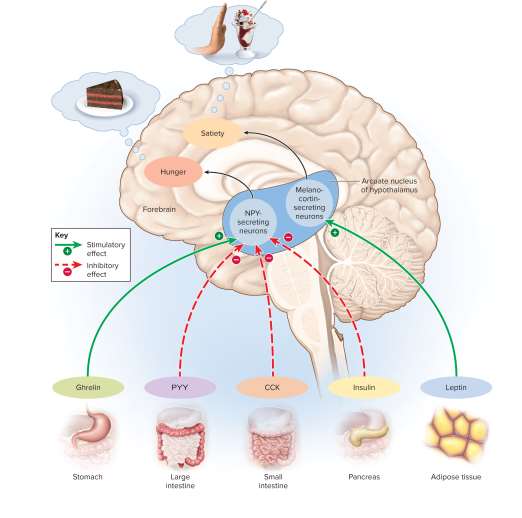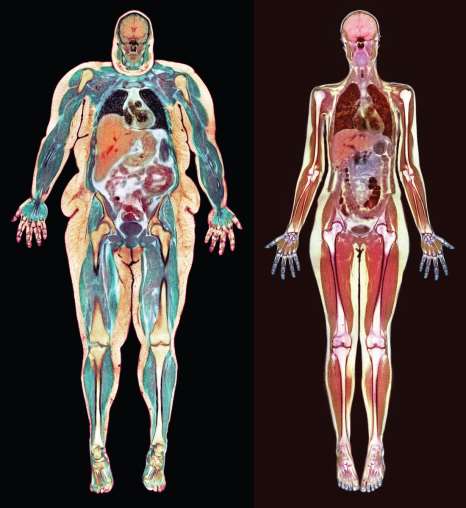Chapter 26, Lesson 1: Nutrition
1/31
Earn XP
Description and Tags
Flashcards from Chapter 26, Lesson 1 of McGraw Hill Anatomy and Physiology, Tenth Edition, by Kenneth S. Saladin.
Name | Mastery | Learn | Test | Matching | Spaced |
|---|
No study sessions yet.
32 Terms
Body weight
Determined by energy balance; gain or loss determined by difference between intake and output around a person’s set point (varies ~30-50% due to heredity, environment, activity, eating)
Appetite
Mechanisms that control feelings of hunger and satiation that can vary with age, weight, and other factors and work over periods of minutes to hours
Appetite regulators
Short-term hormones:
Ghrelin
Peptide YY (PYY)
Cholecystokinin (CCK)
Amylin
Long-term hormones:
Leptin
Insulin
Ghrelin
Short-term appetite regulator made in the stomach’s fundus that causes feelings of hunger and stimulates hypothalamus growth hormone production, nutrient absorption preparation
Secretion stopped after an hour of eating
Peptide YY (PYY)
Short-term appetite regulator made in the enteroendocrine cells of the ileum and colon that senses food arrival for satiation
Cholecystokinin (CCK)
Short-term appetite regulator secreted in the duodenum and jejunum that simulates bile and pancreatic enzyme secretion for satiation
Amylin
Short-term appetite regulator that promotes satiation and inhibits stomach activity
Leptin
Long-term appetite regulator secreted by adipocytes that indicates fat levels; stimulates nerve fibers to produce norepinephrine for fat breakdown (lipolysis)
Deficient receptors can cause obesity in some cases
Insulin
Long-term appetite regulator secreted by the pancreas to stimulate glucose and amino acid uptake as well as glycogen and fat synthesis; helps index fat stores with weaker effect than leptin

Hypothalamus
An important center of appetite regulation in the brain
Hunger contractions
Contractions within the stomach after emptying that increase in intensity over a period of hours; can be briefly satisfied by chewing and stomach filling but requires nutrition for satiation

Obesity
Having a body weight more than 20% the recommended norm for one’s age, sex, and height; can be caused by heredity and overfeeding for a shortened life expectancy
Body mass index (BMI)
Number used as an indication of being overweight or obese; calculated based on weight and height
Calorie
A measure of the capacity to do biological work; specifically, the amount of heat required to raise the temperature of 1 gram of water 1 degree celcius
Kilocalorie (kcal)
1,000 calories
4 kcal per gram
The calorie density of carbohydrates and proteins
7 kcal per gram
The calorie density of alcohol and sugars that provide few nutrients and suppress appetite
9 kcal per gram
The calorie density of fats
Nutrient
Any ingested chemical used for growth, repair, or maintenance of the body
Macronutrients
Water, carbohydrates, lipids, and proteins — these are required in larger quantities
Micronutrients
Vitamins and minerals — these are required in small quantities
Carbohydrate
Macromolecule that serves as an easily absorbed source of fuel in greater amounts for cells; regulated by insulin and glucagon and can be found in plants, grains, and milk
130 grams
The recommended daily allowance for carbohydrates
120 grams
The amount of carbohydrates that the brain consumes each day
Hypoglycemia
Blood glucose deficiency that can cause nervous system disturbances, weakness, and dizziness
Glycemic index (GI)
The effect of dietary carbohydrates on blood glucose levels; higher indexes stimulate higher demands and thus increase obesity and type 2 diabetes mellitus risks
Fiber
Fibrous material that resists digestion — not technically a nutrient but allows for smoother digestive function
Lipids (fats)
Macronutrient that accounts for 80-90% of an adult’s resting energy needs through energy stores; very dense at 9 kcal per gram and aids vitamin absorption (lower consumption equates to vitamin deficiency)
High-density lipoproteins (HDLs)
“Good” cholesterol found in healthier fatty foods; indicates cholesterol is being removed from arteries and transported to the liver for disposal
Low-density lipoproteins (LDLs)
“Bad” cholesterol found in unhealthy fatty foods; can be increased via smoking, saturated fat intake, coffee, and stress but is lowered via vigorous exercise
Protein
Macromolecule that constitutes 12-15% of body mass with 65% in skeletal muscles; contributes to muscle contraction, cell components, pH buffers and are made of amino acids from the diet or synthesized by the body
Minerals and vitamins
Micronutrients that are not used as fuel but nutrient absorption aids that mainly come from the diet in small amounts; function in pH buffering, enzymatic action, blood functions